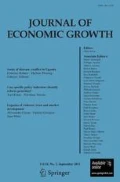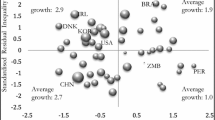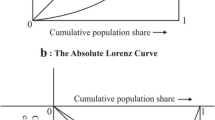Abstract
This paper describes the correlations between inequality and the growth rates in cross-country data. Using non-parametric methods, we show that the growth rate is an inverted U-shaped function of net changes in inequality: changes in inequality (in any direction) are associated with reduced growth in the next period. The estimated relationship is robust to variations in control variables and estimation methods. This inverted U-curve is consistent with a simple political economy model but it could also reflect the nature of measurement errors, and, in general, efforts to interpret this evidence causally run into difficult identification problems. We show that this non-linearity is sufficient to explain why previous estimates of the relationship between the level of inequality and growth are so different from one another.
Similar content being viewed by others
References
Acemoglu, D., and F. Zilibotti. (1997) “Was Prometheus Unbound by Chance? Risk, Diversification, and Growth,” Journal of Political Economy 105(4), 709-751.
Acemoglu, D., and J. Robinson. (2000). “Why did the West Extend the Franchise? Democracy, Inequality and Growth in Historical Perspective,” Quarterly Journal of Economics 115(4), 1167-1199.
Aghion, et al. (1999). “Dualism and Macro-Economic Stability,” Quarterly Journal of Economics 114(4), 1359-1397.
Aghion, P., and P. Bolton. (1997). “A Trickle-Down Theory of Growth and Development with Debt Overhang,” Review of Economic Studies 64(2), 151-172.
Alesina, A., and D. Rodrik. (1994). “Distributive Politics and Economic Growth,” Quarterly Journal of Economics 109(2), 465-490.
Alesina, A., and R. Perotti. (1996). “Income Distribution, Political Instability and Investment,” European Economic Review 81(5), 1170-1189.
Angrist, J. D., and A. B. Krueger. (1999). “Empirical Strategies in Labor Economics,” In Orley Ashenfelter and David Cards, eds., Handbook of Labour Economics, Vol. 3A. Amsterdam: North Holland: 1277-1366.
Arellano, M., and S. Bond. (1991). “Some Tests of Specification for Panel Data: Monte Carlo Evidence and an Application to Employment Equations,” Review of Economic Studies 58, 277-297.
Atkinson, A. B., and A. Brandolini. (2001). “Promise and Pitfalls in the use of ‘secondary’ Data-Sets: Income Inequality in OECD Countries as a Case Study,” Journal of Economic Literature 39(3), 771-799.
Banerjee, A., and A. Newman. (1993). “Occupational Choice and the Process of Development,” Journal of Political Economy 101(2), 274-298.
Banerjee, A., and A. Newman. (1994). “Poverty, Incentives, and Development,” American Economic Review 84(2), 211-215.
Banerjee, et al. (2001). “Inequality, Control Rights and Rent Seeking: Sugar Cooperatives in Maharashtra,” Journal of Political Economy 109(1), 138-190.
Barro, R. J. (2000). “Inequality and Growth in a Panel of Countries,” Journal of Economic Growth 5(1), 5-32.
Benabou, R. (2000). “Unequal Socities: Income Distribution and the Social Contract,” American Economic Review 90(1), 96-129.
Benhabib, J., and A. Rustichini. (1998). “Social Conflict and Growth,” Journal of Economic Growth 1(1), 143-158.
Benhabib, J., and M. M. Spiegel. (1998). “Cross-Country Growth Regressions,” Mimeo.
Caselli, et al. (1996). “Reopening the Convergence Debate: A New Look at Cross-Country Growth Empirics,” Journal of Economic Growth 1, 363-389.
Dasgupta, P., and D. Ray. (1986). “Inequality as a Determinant of Malnutrition and Unemployment: Theory,” The Economic Journal 96(384), 1011-1034.
Deininger, K., and L. Squire. (1996). “A New Data Set Measuring Income Inequality,” World Bank Economic Review 10, 565-591.
Forbes, K. J. (2000). “A Reassessment of the Relationship Between Inequality and Growth,” American Economic Review 90(4), 869-887.
Galor, O., and J. Zeira. (1993). “Income Distribution and Macroeconomics,” Review of Macroeconomic Studies 60, 35-52.
Greenwood, J., and B. Jovanovic. (1999). “The Information Technology Revolution and the Stock Market,” American Economic Review 89(2), 116-122.
Hausman, J. A., and W. Newey. (1995). “Nonparametric Estimation of Exact Consumers Surplus and Deadweight Loss,” Econometrica 63(6), 1445-1476.
Krueger, A., and M. Lindahl. (2001). “Education for Growth: Why and for Whom?” Journal of Economic Literature 39(4), 1101-1136.
Li, Hongyi, and Heng-fu Zou. (1998). “Income Inequality is not Harmful for Growth: Theory and Evidence,” Review of Development Economics 2(3), 318-334.
Perotti, R. (1996). “Growth, Income Distribution and Democracy,” Journal of Economic Growth 1, 149-187.
Persson, T., and G. Tabellini. (1991). “Is Inequality Harmful for Growth? Theory and Evidence,” American Economic Review 48, 600-621.
Piketty, T. (1997). “The Dynamics of the Wealth Distribution and the Interest Rate with Credit Rationing,” Review of Economic Studies 64(2), 173-189.
Porter, J. (1996). “Essays in Econometrics,” PhD dissertation, MIT.
Robinson, P. (1988). “Root-n Consistent Semiparametric Regressions,” Econometrica 56, 931-954.
Srinivasan, T. N. (1994). “Destitution: A Discourse,” Journal of Economic Literature 32(4), 1842-1855.
Author information
Authors and Affiliations
Rights and permissions
About this article
Cite this article
Banerjee, A.V., Duflo, E. Inequality and Growth: What Can the Data Say?. Journal of Economic Growth 8, 267–299 (2003). https://doi.org/10.1023/A:1026205114860
Issue Date:
DOI: https://doi.org/10.1023/A:1026205114860




